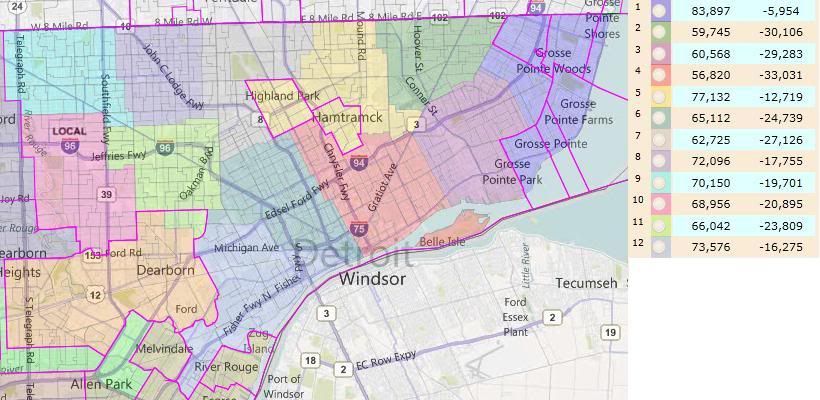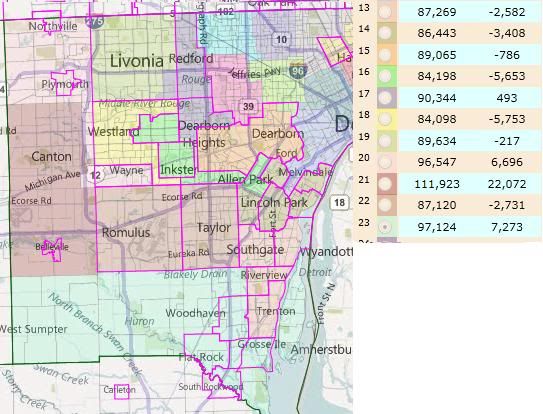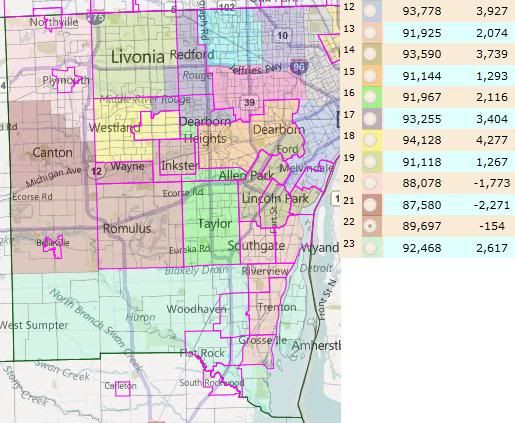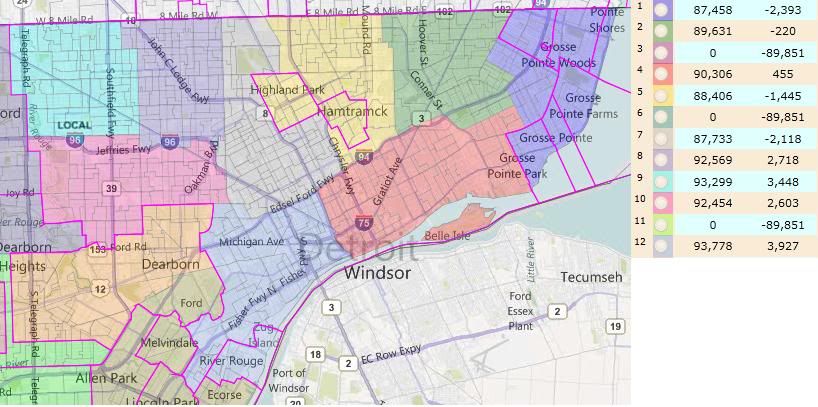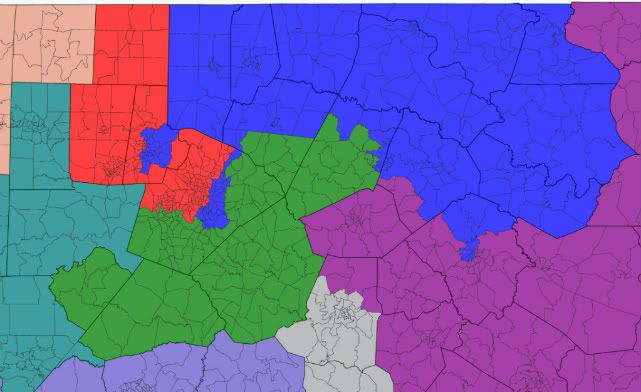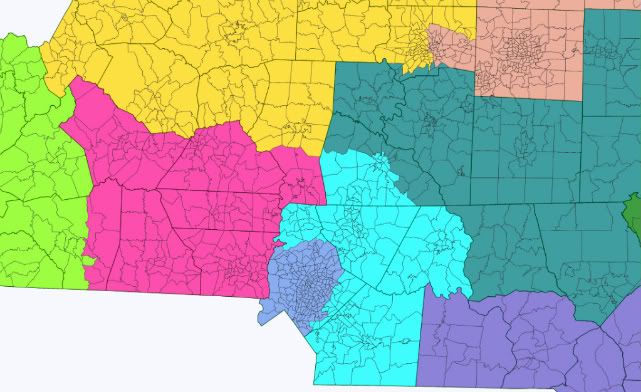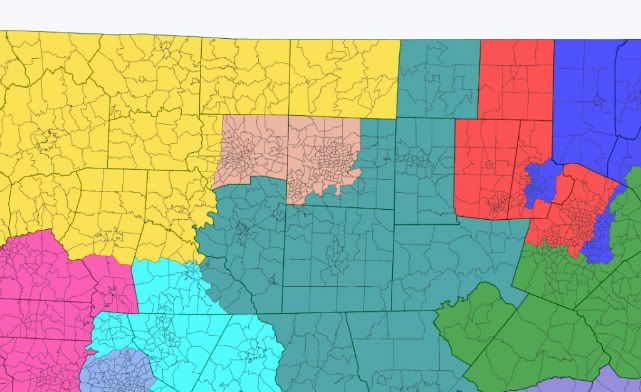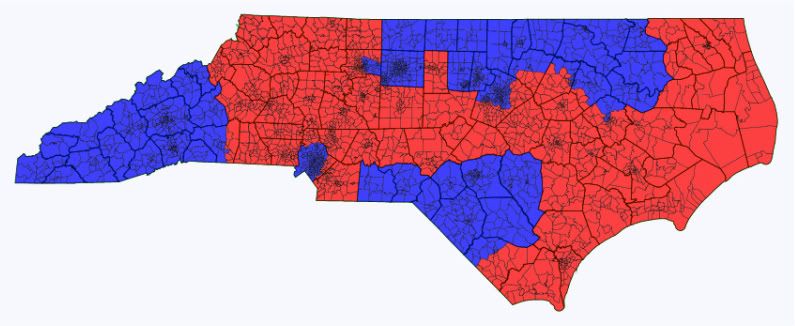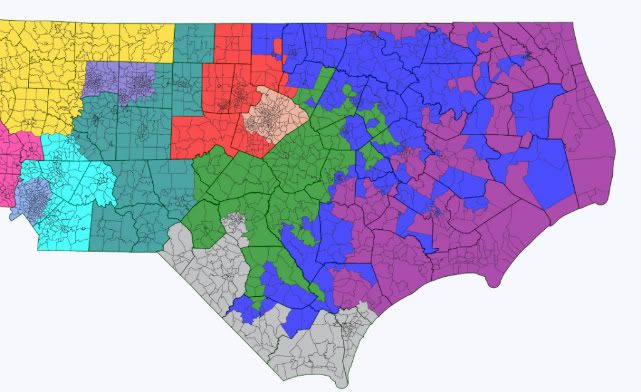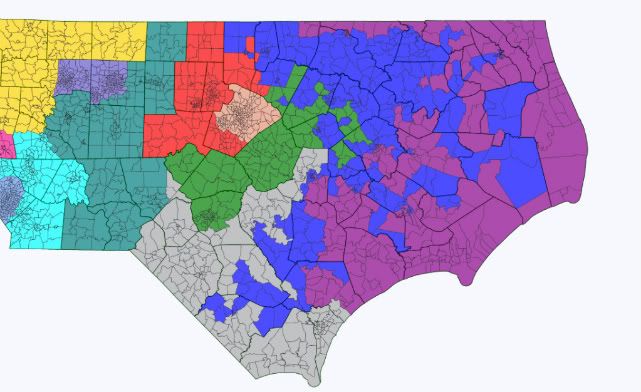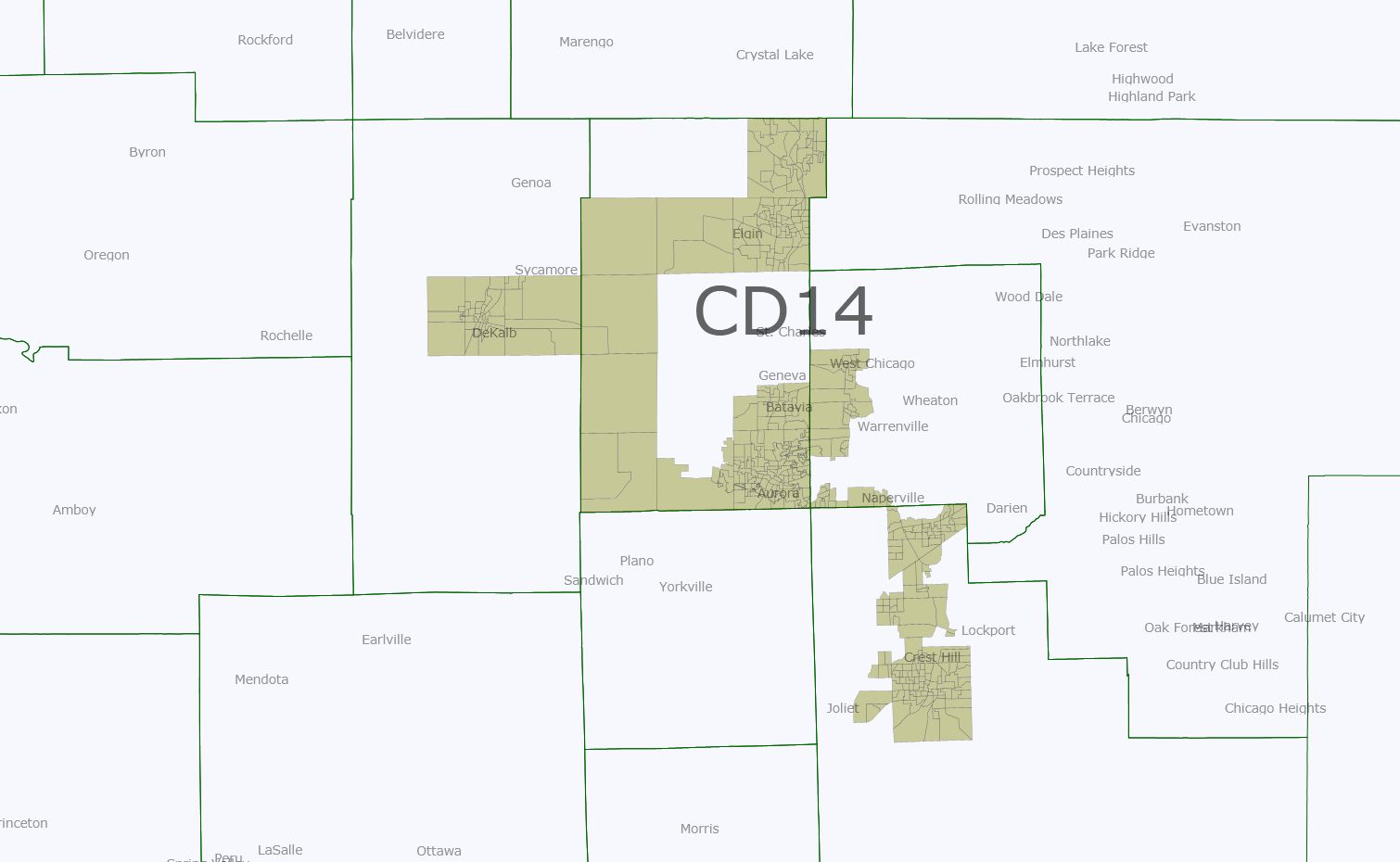The partisan data is still not in the Application. Nevertheless, I wanted to post this DRAFT map now that the Census numbers are out.
I feel that my first attempt 15-3 map was perhaps too ambitious, but I feel confident that 14-4 is VERY doable in Illinois — ofcourse, the lines will have to be ugly like this “Texas-style” map.
I had several goals:
1.) Keep all 3 black seats intact; not easy considering hundreds of thousands of blacks have left Chicago over the last decade.
2.) Create two Hispanic seats — ones that would be guaranteed to elect Hispanic representatives.
3.) Keep all currently Democratic-held seats at very high Democratic levels (this includes the minority-majority seats, ofcourse, as well as IL-3, IL-5, IL-9, and IL-12).
4.) Create seats where the incumbent Democrat would keep as much of his or her current constituents as possible.
5.) Create a map whereby there are only 4 Republican seats, the newly created Democratic seats must be at relatively high Democratic levels – ideally around 65% Obama or higher in the Chicago area and around 60% Obama or higher in downstate and/or 5 points more Democratic than the existing seat.
6.) As a finishing touch, create a map whereby Aaron Schock and Adam Kinzinger will basically not have a seat to run in.
Here’s the map:
Goal 1: Preserving African-American seats – under this map, virtually all black-majority precincts in the Chicago area become parts of the 3 black-majority districts. The reason the black percentage goes down in all 3 seats is because hundreds of thousands of blacks have left the area over the last decade.
New IL-1 is 51.3 black, 38.7 white (18+ pop. is 51.5 black, 40.1 white) – Rush gets to keep 53% of his current constituents, including 75% of his current black constituents.
New IL-2 is 51.8 black, 37.2 white (18+ pop. is 50.1 black, 40.5 white) – Jackson gets to keep 80% of his current constituents, including 83% of his current black constituents.
New IL-7 is 51.8 black, 34.8 white (18+ pop. is 50.1 black, 37.5 white) – Davis gets to keep 59% of his current constituents, including 90% of his current black constituents.
Goal 2: Two Effective Hispanic seats
New IL-4 is 56.0 hispanic, 33.2 white (18+ pop. is 50.4 hispanic, 38.9 white) – these percentages are enough to elect a Hispanic Representative as IL-4 encompasses the mostly Puerto Rican-descent areas on the north side of Chicago where the Hispanics are all citizens. It makes sense to me that Gutierrez would run here.
New IL-6 is 64.1 hispanic, 25.1 white (18+ pop. is 58.5 hispanic, 30.1 white) – this area encompasses the mostly Mexican-descent areas on the south side of Chicago where there’s a higher proportion of non-citizens, so I made the Hispanic percentage here noticeably higher in order to make sure that a Hispanic Representative is elected.
Goal 3: Make sure all currently Democratic-held seats are safely Democratic.
My estimate is that the 3 new black-majority seats and the 2 new hispanic seats above are all in the 75-79 Obama range (ofcourse, there’s currently only one hispanic seat but I’m classifying IL-4 and IL-6 as “Dem-held” as Gutierrez currently represents roughly half of each district) …
For the other currently Democratic-held seats the partisan numbers (ESTIMATED Obama as a percentage of the 2-party vote) are as follows:
New IL-3 is 62.3 Obama (current district is 64.4 Obama)
New IL-5 is 68.3 Obama (current district is 73.9 Obama)
New IL-9 is 70.2 Obama (current district is 73.2 Obama)
New IL-12 is 60.9 Obama (current district is 56.4 Obama)
Goal 4: Incumbent-protection
I already discussed above what percentage of their constituents the Democrats in the minority-majority seats would keep. For the other Democratic incumbents the numbers are as follows:
New IL-3: Lipinski gets to keep 33% of his current constituents (that’s the lowest percentage of all incumbent Democrats but a good chunk of the new Hispanic-majority IL-6 comes out of territory that’s currently a part of IL-3).
New IL-5: Quigley gets to keep 70% of his current constituents
New IL-9: Schakowsky gets to keep 75% of her current constituents
New IL-12: Costello gets to keep 63% of his current constituents
Goal 5: Get rid of 7 of the current 11 GOP members through re-drawing of lines.
– As already mentioned, IL-6 goes from a suburban GOP district to a Hispanic-majority Democratic district based in Chicago (ofcourse, Roskam can run in the new IL-16 which becomes sort of a Chicago-area GOP vote sink).
– New IL-8 is 65.1 Obama (current district is 56.5 Obama), so Walsh is history (or he can run in the new IL-16). The new IL-8 should be friendly to Bean if she wants to make a comeback.
– New IL-10 is 65.3 Obama (current district is 61.5 Obama), plus the district has a lot of new territory, including the entire Lake Michigan shoreline — so Dold is history.
– New IL-11 is 59.2 Obama (current district is 54.2 Obama). Only 19% of Kinzinger’s current constituents remain in IL-11 under the new lines, so his base basically disappears with this map. Also, the new IL-11 includes 3 major university towns. It’s likely that this district would flip back to the Democratic side in 2012.
– New IL-14 is 62.4 Obama (current district is 55.6 Obama). Hultgren won here over Foster by 51-45 (with the Green candidate at 4%) in a major GOP year, so the 7-point Democratic increase should more than do the job. (Hultgren can run in the new IL-16 ofcourse.)
– New IL-17 is 60.8 Obama (current district is 57.2 Obama). The lines are scrambled here considerably (less than half of the population of the new IL-17 comes out of Schilling’s current constituency) and most of Rockford is now included. I really believe that almost any Democrat other than Hare would have no trouble here in 2012.
– IL-19 no longer exists, so that’s also one less Republican (although Shimkus may want to run in the new IL-18 — see below).
By my estimate, John Kerry would have won all of the 14 Democratic seats created by this map.
The four GOP seats that remain:
– IL-13: now transferred to the southern reaches of the state but without an incumbent. Although Republican, less so than the other 3 GOP seats, so perhaps a possibility that a moderate to conservative Democrat could win here.
– IL-15: Johnson gets to keep 67% of his current constituents under the new lines.
– IL-16: The most likely Republicans to run here include Manzullo, Walsh, Hultgren, Roskam and Biggert (not necessarily in that order) — yes, the map packs these 5 into one district, with a few Dold precincts also included !
– IL-18: designed more for Shimkus than for Schock — 29% of the new district’s population comes out of Shimkus’ current district, while only 20% comes out of Schock’s … which brings me to the last goal …
Goal 6: Make it hard for Kinzinger and Schock
I already discussed Kinzinger a bit above. Basically, the current IL-11 gets split as follows: 19% of Kinzinger’s constituents remain in IL-11; 30% go into the new IL-2; 22% into IL-1; 18% into IL-3; 6% into IL-15; and 5% into IL-18.
As far as Schock, his current district is likewise torn apart; the highest proportion of his current constituents (30%) goes to IL-15; the rest is divided among IL-11 (27%); IL-18 (20%); IL-13 (15%); IL-12 (7%); with a sliver going to IL-17.
To briefly sum up my map:
1.) Democratic; black-majority; Rush
2.) Democratic; black-majority; Jackson
3.) Democratic; 62.3 Obama; Lipinski
4.) Democratic; hispanic-majority; Gutierrez
5.) Democratic; 68.3 Obama; Quigley
6.) Democratic; hispanic-majority; new Hispanic representative (?)
7.) Democratic; black-majority; Davis
8.) Democratic; 65.1 Obama; Bean (?)
9.) Democratic; 70.2 Obama; Schakowsky
10.) Democratic; 65.3 Obama; new Dem. representative (?)
11.) Democratic; 59.2 Obama; new Dem. representative (?)
12.) Democratic; 60.9 Obama; Costello
14.) Democratic; 62.4 Obama; Foster (?)
17.) Democratic; 60.8 Obama; new Dem. representative (?)
13.) Republican; new GOP Rep. (?)
15.) Republican; Johnson
16.) Republican; Manzullo, Hultgren or Walsh most likely to win here
18.) Republican; Shimkus



